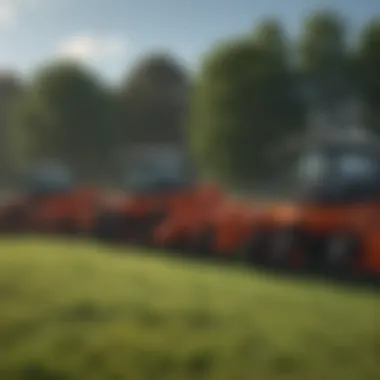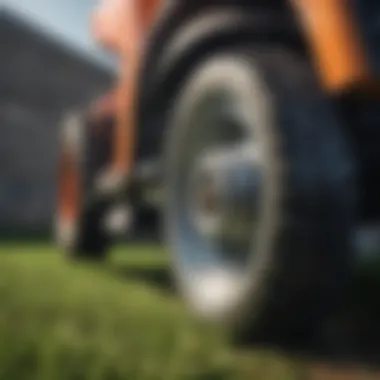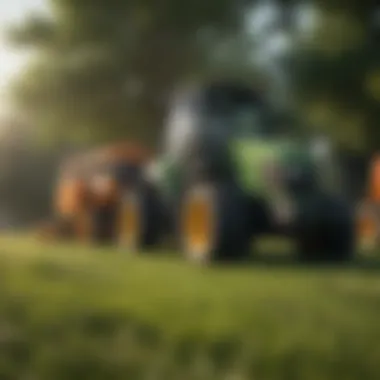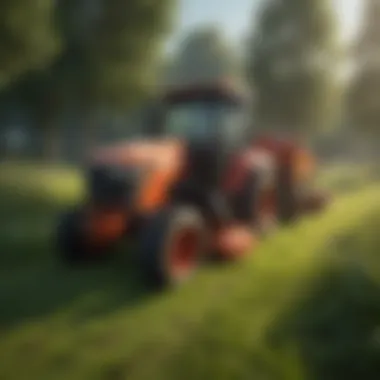Comprehensive Guide to Grass Cutting Machines


Intro
The landscape of agriculture is undergoing significant transformation, driven by technological advancements and evolving practices. At the heart of this revolution lies the efficiency of grass cutting machines, a vital component for maintaining both agricultural and recreational lands. Understanding these machines is critical for agriculture farmers and enthusiasts who aim to optimize their grass management strategies.
This guide seeks to illuminate the intricacies of grass cutting machinery. It will delve into the types available, the technologies involved, and the importance of maintenance. Furthermore, it will explore the innovative practices enhancing efficiency and sustainability within the field. Whether you are a novice or a seasoned professional, the upcoming sections will provide you with valuable insights to advance your agronomy practices.
Prologue to Grass Cutting Machines
Grass cutting machines play a significant role in maintaining the aesthetic and health of lawns, gardens, and agricultural fields. With the evolution of modern agronomy, understanding these machines becomes not just beneficial, but necessary. They help in enhancing productivity, ensuring proper grass management, and contributing to environmentally sustainable practices. This article provides an overview of different types of grass cutting equipment, their functions, and their importance in both personal and commercial landscapes.
Historical Overview
The concept of cutting grass dates back to ancient civilizations, where tools were crafted from readily available materials. The first mowers were essentially handheld devices made for manual cutting. By the 19th century, industrial revolution sparked innovations. In 1830, Edwin Beard Budding invented the first mechanical lawn mower in England, which utilized a cylinder-based mechanism. This design was revolutionary at that time, allowing for more efficient and effective grass cutting compared to manual methods.
As time progressed, gasoline and electric-powered lawn mowers emerged in the 20th century. Today, robotic mowers represent the latest advancement, allowing for autonomous grass cutting. Through the ages, these innovations have enhanced the ability to manage grasses efficiently while reducing physical labor.
Importance in Agriculture and Horticulture
Grass cutting machines serve multiple vital functions within the fields of agriculture and horticulture:
- Efficiency: They drastically reduce the time and effort needed to maintain grass in large areas, from lawns to agricultural fields.
- Health Improvement: Regular cutting promotes healthier grass growth by encouraging denser, more vibrant turf.
- Precision: Modern machines provide various cutting heights and techniques, allowing tailored care for different grass types and situations.
- Environmental Impact: In agricultural settings, properly managed grass can improve soil health and reduce weeds, contributing to sustainable farming practices.
Given these factors, the significance of understanding different types of grass cutting machines is clear. Whether for residential gardens or expansive agricultural landscapes, choosing the right tools is essential for optimal maintenance and sustainability.
Types of Grass Cutting Machines
Understanding the different types of grass cutting machines is crucial for both casual homeowners and professional landscapers. Each type has its own unique attributes, addressing specific needs based on the user’s yard size, terrain, and maintenance preferences. Knowing these differences enables better purchasing decisions and enhances the overall efficiency of yard maintenance.
Manual Mowers
Manual mowers, also known as push mowers, are simple devices powered by human effort rather than fuel or electricity. They consist of a reel or cylinder that cuts the grass as the mower moves forward. These mowers are lightweight, quiet, and eco-friendly, making them a suitable choice for small to medium-sized lawns. They offer a more intimate mowing experience, allowing users to enjoy the activity of lawn care.
Some benefits of manual mowers include:
- Cost-effectiveness: Typically, they are less expensive than their powered counterparts.
- Low Maintenance: Fewer moving parts mean less maintenance compared to electric or gas models.
- Environmentally Friendly: They produce no emissions, promoting sustainable practices.
Electric Mowers
Electric mowers can be divided into corded and cordless options. Corded mowers plug into a power outlet, whereas cordless mowers use rechargeable batteries. These machines are popular for their ease of use and minimal maintenance requirements.
Key advantages include:
- Quiet Operation: Electric mowers are generally quieter than gas-powered models.
- No Emissions: There’s no need to worry about fumes, making them an eco-friendly choice.
- User-friendly: These mowers are often lighter and easier to maneuver.
While electric mowers might not be ideal for very large lawns due to battery life or extension cord reach, they fit well in suburban settings where noise and emissions can be a concern.
Gas-Powered Mowers
Gas-powered mowers are a preferred choice for larger lawn areas. They offer greater power and can tackle tougher grass types and uneven terrain with ease. These mowers typically boast more features like height adjustment and larger cutting decks, leading to higher efficiency.
However, they do come with some drawbacks:
- Higher Noise Levels: They operate with a louder engine sound compared to electric models.
- Emissions: Gas mowers contribute to air pollution, which is a significant concern for environmentally conscious users.
- More Maintenance: Requires regular maintenance of the engine and fuel systems.
Robotic Lawn Mowers
Robotic lawn mowers represent a significant leap in lawn maintenance technology. These machines operate autonomously, using advanced sensors and mapping technologies to navigate and cut grass without human intervention. They are perfect for tech-savvy homeowners who prefer a hands-off approach to yard care.
Pros of robotic mowers include:
- Convenience: They do the work while users attend to other tasks, saving time.
- Uniform Cutting: They can provide consistent grass cutting, as they often operate on a scheduled basis.
- Smart Technology Integration: Many models can connect to smartphone applications for easy control and monitoring.
Trimmers and Edgers
Trimmers and edgers are often supplementary tools used in conjunction with mowers. Trimmers, or string trimmers, are designed to reach areas a mower cannot, such as around flower beds and fences. Edgers are used to create a clean edge along pathways and driveways.
Highlights of these tools include:
- Precision Cutting: Ideal for achieving clean lines and detail work.
- Versatility: Works well in varied terrain where mowers might struggle.
- Lightweight Options Available: Many models are easy to handle for extended periods.


Operating Principles of Grass Cutting Machines
Understanding the operating principles of grass cutting machines is essential for maximizing their efficiency and effectiveness. These machines vary in design, functionality, and application, but their underlying principles reflect the core mechanics that facilitate grass cutting. Knowledge of these principles can lead to better maintenance and use, ultimately affecting the quality of the job done.
Fundamental Mechanical Components
Grass cutting machines consist of various mechanical components, each playing a vital role in the overall system. Some key components include:
- Engine or Motor: This is the powerhouse of the machine. In gas-powered mowers, the internal combustion engine generates the necessary power. In electric models, a motor provides similar functionality, often with less noise and emissions.
- Cutting Deck: This is the housing that contains the cutting blade or blades. The design of the cutting deck affects grass flow and cutting efficiency, which can vary significantly based on whether the machine is mulching or bagging.
- Blades: The cutting blades, which can be stationary or rotating, directly influence the grass cutting quality. Their sharpness, material, and design matter since dull blades can tear grass, leading to disease.
- Wheels and Drive Systems: The wheels allow for mobility across various terrains, while the drive system (which may be push or self-propelled) affects ease of use.
- Adjustment Mechanisms: Many machines now feature tools to easily adjust the cutting height, enabling users to customize the cut according to grass type and seasonal growth patterns.
By understanding these components and how they interact, users can maintain their machines more effectively and select the right equipment for their needs.
Blade Mechanics and Cutting Techniques
Blade mechanics are critical to the operation of grass cutting machines. The design of the blade can significantly impact the cutting technique employed.
- Rotating Blades: Most common in rotary mowers, these blades spin at high speeds. The centrifugal force lifts the grass, allowing for a clean cut.
- Reel Blades: Used in reel mowers, these blades operate similarly to scissors, with one blade shearing against another. This method can result in a healthier lawn, as it minimizes tearing.
- Cutting Height Settings: Optimal blade adjustment ensures that grass is cut to a suitable height. Cutting too short can stress the plants; cutting too high may lead to pest and weed issues.
Moreover, users should adapt their cutting techniques based on grass type and environmental conditions. For instance, damp grass requires a different approach compared to dry grass. Understanding these mechanics leads to not only cleaner cuts but also a better-maintained lawn overall.
"Efficiency in grass cutting does not merely rely on machine capability. It is equally tied to an operator's comprehension of how their tools work."
For optimal results, users must integrate knowledge of mechanical components and blade mechanics into their maintenance routines and operational tactics.
Technological Advancements in Grass Cutting
Technological advancements in grass cutting significantly change how land management is approached. Innovations in this area not only enhance efficiency but also promote sustainable practices. With growing concerns about environmental impact, technology offers solutions addressing both productivity and ecological balance. These advancements are pivotal for farmers and horticulturists seeking to optimize their operations.
Electric vs. Gas-Powered Efficiency
When comparing electric and gas-powered machines, several efficiency factors must be considered. Electric mowers typically offer lower operational costs. They are less expensive to maintain and operate. Furthermore, they generate less noise and emissions, which makes them ideal for residential areas and urban settings.
On the other hand, gas-powered machines often provide more power for larger lawns. They can tackle thicker grasses and offer extended run times without needing to recharge. However, they come with higher fuel costs and can be more challenging for maintenance too.
Ultimately, the choice between electric and gas-powered options should align with the user's specific needs. Factors like lawn size, terrain, and personal environmental considerations will guide this choice.
Integration of Smart Technology
The integration of smart technology in grass cutting machinery represents a major leap forward. Smart lawn mowers offer features like GPS navigation, allowing for precise cutting patterns and efficient use of resources. Through app connectivity, users can schedule mowing times, monitor machine performance, and receive notifications about maintenance needs.
"Smart technology in grass cutting machines ensures optimal performance, reducing the need for manual labor and manual adjustments."
In addition, many modern machines can be programmed to adapt to different grass types and conditions. This adaptability improves the quality of cutting while minimizing the strain on the machine. Furthermore, the data collected can inform users about patterns and areas that require more focus or adjustment.
This shift towards smart technology not only enhances the user experience but contributes positively to the overall sustainability of grass management practices.
Environmental Considerations
Environmental considerations play a vital role in the discussion of grass cutting machines due to their potential impact on the ecosystem and the importance of sustainable practices. As these machines become ubiquitous in both residential and commercial landscapes, understanding their environmental footprint is crucial for responsible usage. This section aims to examine the sustainability aspects of grass cutting as well as the management of factors such as noise pollution.
Sustainable Practices in Grass Cutting
Adopting sustainable practices in grass cutting involves utilizing methods that reduce negative environmental impacts. This can include selecting energy-efficient models or optimizing operational strategies. One effective approach is the use of electric mowers instead of conventional gas-powered alternatives. Electric mowers produce lower emissions and contribute less to air pollution. They also often operate more quietly, minimizing disturbance in residential areas. The use of mulching mowers aids in reducing lawn waste by recycling grass clippings back into the soil, enriching it with nutrients and organic matter, thus avoiding the disposal process.
Some additional sustainable practices include:
- Scheduled Cutting: Alter cutting schedules to align with growth cycles, allowing grass to grow longer during cooler months.
- Proper Blade Maintenance: Ensuring blades are sharp can enhance cutting efficiency and reduce energy consumption.
- Regular Maintenance: Keeping machines well-maintained prevents excess fuel consumption and prolongs the lifespan of the equipment.
Implementing such methods ensures that grass cutting aligns with environmental stewardship and promotes healthier landscapes.
Noise Pollution and Its Management
Noise pollution is a significant concern when using grass cutting machines, particularly in densely populated areas. The sound produced by gas-powered mowers can exceed acceptable noise levels, leading to disturbances for neighbors and wildlife. It also contributes to stress for people working or living nearby.
To mitigate noise pollution, consider the following strategies:
- Choosing Quieter Machines: Opt for electric mowers or newer models specifically designed for quieter operation.
- Time Management: Operate machines during designated hours to minimize disruption to the community.
- Regular Maintenance: Keeping machines in good working order can help reduce operational noise.
Implementing effective noise management strategies not only benefits the environment but also fosters better community relations.


Overall, addressing the environmental considerations related to grass cutting machines is crucial. By embracing sustainable practices and managing noise pollution, users can contribute to a healthier ecosystem and a more pleasant environment for all.
Maintenance of Grass Cutting Machines
Maintaining grass cutting machines is crucial for their efficiency and longevity. Regular maintenance helps prevent breakdowns, ensures optimal performance, and extends the overall life of the equipment. This aspect aligns with the goal of efficient grass management, particularly for those in agriculture and horticulture. Without proper upkeep, even the most advanced machines can falter, leading to increased costs and reduced productivity.
Routine Maintenance Schedules
Establishing a routine maintenance schedule is essential for any grass cutting machine owner. These schedules may vary based on the type and usage of the machine, but they generally include the following:
- Daily Checks: Inspecting the machine for visible wear or damage, and ensuring that blades are sharp and properly aligned.
- Weekly Maintenance: Cleaning the machine to remove grass clippings and debris that may affect performance. Checking fluid levels, such as oil and fuel, to ensure they are within appropriate ranges.
- Monthly Maintenance: Inspecting belts and cables for tension, wear, or slippage. Replacing air filters as necessary.
- Seasonal Maintenance: A more in-depth check at the start and end of each mowing season. This should include sharpening blades, changing oil, and inspecting the overall condition of the machine.
By adhering to these schedules, one can mitigate the risk of unexpected issues and ensure that the machine operates smoothly.
Troubleshooting Common Issues
Even with regular maintenance, grass cutting machines can encounter problems. Here are some common issues along with troubleshooting tips:
- Unresponsive Engine: If the machine fails to start, check the ignition system and fuel levels. Ensure that the battery is charged if applicable.
- Uneven Cutting: This may result from dull blades or incorrect height settings. Sharpen the blades and adjust settings as needed.
- Overheating: This can occur due to dirt buildup or insufficient oil. Clean the engine and check the oil levels to prevent overheating.
- Vibrations or Noises: Unusual sounds may indicate loose parts or imbalanced blades. Inspect the machine for loose bolts and ensure blade balance.
Proper maintenance and troubleshooting can significantly extend the lifespan of grass cutting machines, saving costs and improving performance.
Choosing the Right Grass Cutting Machine
Choosing the right grass cutting machine is crucial for both efficiency and effectiveness in maintaining lawns and gardens. The selection process incorporates various factors that can significantly impact performance, convenience, and overall user satisfaction. A well-chosen grass cutting machine can save time, reduce labor, and ultimately produce better lawn quality. Understanding your specific needs is essential to make an informed decision.
Assessing Yard Size and Terrain
The first step towards choosing a suitable grass cutting machine is assessing the size of your yard and its terrain. Different machines are designed to handle various lawn dimensions and surfaces.
- Small Lawns: For smaller areas, manual mowers or electric mowers are often appropriate. They are typically lightweight and easier to maneuver.
- Medium to Large Lawns: For bigger properties, gas-powered mowers or riding mowers become beneficial. They are capable of covering more ground quickly.
- Terrain Considerations: Consider the type of terrain as well. If your lawn has inclines or uneven surfaces, a self-propelled mower may offer better control. Flat lawns can often handle standard push mowers effectively.
Budget Considerations
Budget is a significant factor when choosing a grass cutting machine. The investment must align with your financial capacity while also meeting long-term needs.
- Entry-Level Options: For budget-conscious individuals, manual or basic electric mowers are accessible choices. They require lower initial costs.
- Mid-Range Models: Mid-range electric and gas-powered models offer additional features, requiring moderate investment but providing better performance.
- High-End Machines: Professional-grade or premium models carry higher price tags, but they deliver enhanced durability, advanced technology, and features like mulching capabilities.
Before making a purchase, be aware of ongoing costs such as maintenance, fuel, or electricity. A comprehensive view of both immediate and future expenses ensures you choose a machine that is financially sustainable.
User Experience and Comfort
User comfort plays a critical role in selecting a grass cutting machine. The physical demands of mowing can be significant, so considering ergonomic features could greatly enhance your experience.
- Weight and Maneuverability: Lightweight models tend to be easier to handle. Ensure that the mower you choose is user-friendly in terms of weight and ease of steering.
- Handles and Controls: Adjustable handles can help cater to different user heights, promoting a more comfortable mowing position. Ensure controls are easy to reach without straining.
- Noise Level: Machines vary in noise output. Quiet operation can be essential if you live in a residential area where disturbances may cause issues.
- Safety Features: Look for models with effective safety features like automatic shutoff mechanisms. This enhances user safety and minimizes the chance of accidents.
Overall, assessing yard size, budget, and user comfort facilitates informed choices, helping you achieve a well-maintained lawn tailored to your requirements.
Innovative Grass Cutting Techniques
Innovative grass cutting techniques are crucial for improving efficiency and sustainability in lawn care. These methods not only enhance the health of the grass but also contribute to a more environmentally friendly approach to lawn maintenance. Understanding the specifics of each technique can help users make more informed decisions, optimizing their grass cutting experience while considering the broader agricultural practices involved.
Mulching vs. Bagging
Mulching and bagging are two prominent techniques used in grass cutting that serve different purposes.
Mulching involves recycling cut grass back into the lawn. This process enriches the soil by providing nutrients, reduces the need for chemical fertilizers, and helps retain moisture. Mulching can also suppress weed growth, contributing to a healthier lawn ecosystem.
Benefits of Mulching:
- Nutrient Supply: Grass clippings decompose and return valuable nutrients to the soil.
- Environmental Impact: It minimizes waste and lowers the carbon footprint associated with disposing of grass clippings.
- Water Conservation: By keeping moisture in the soil, mulching promotes better water usage.
On the other hand, bagging collects grass clippings to be disposed of or used in compost. This technique can provide a cleaner look to the lawn, especially after mowing. Bagging is preferred in instances where grass is overgrown or diseased, as it prevents the spread of pests and diseases across a well-maintained lawn.
Benefits of Bagging:
- Aesthetics: A clean, neat appearance follows from the collection of cut grass.
- Disease Control: Helps to manage and avoid the spread of diseases and pests by removing potential carriers.
- Composting Material: Those grass clippings can be composted, contributing to organic waste management.
Whether a user chooses mulching or bagging will depend on their specific lawn care goals, environmental considerations, and available resources. Both methods have merit, and it is essential to evaluate the best approach suitable for the type of grass and local conditions.


Adjustable Cutting Heights
Adjustable cutting heights in grass cutting machines allow users to customize the length at which grass is cut. This feature is particularly important as the height at which grass is cut directly affects its health and recovery rate. Different types of grass thrive at different cutting heights, and understanding these needs can enhance lawn vitality.
Benefits of Adjustable Cutting Heights:
- Optimized Growth: Keeping grass at an appropriate height boosts photosynthesis and overall health.
- Seasonal Adjustments: Changes in height can be made according to seasonal variations; for instance, a lower cut in spring ensures healthier growth.
- Custom User Experience: Users can tailor their mowing experience based on yard conditions, personal preferences, and specific grass types.
Incorporating these innovative grass cutting techniques can greatly influence lawn health and maintenance efficiency. Effective grass management practices not only contribute to better lawn care outcomes but also align with sustainable agricultural practices.
Future Trends in Grass Cutting Technology
The advancement of technology is transforming various sectors, and grass cutting is no exception. This section investigates future trends in grass cutting technology, emphasizing how innovations improve efficiency and usability. Understanding these trends is crucial for both farmers and gardening enthusiasts aiming to optimize their grass maintenance routines. Furthermore, these trends focus on enhancing the sustainability of practices in land management.
Advances in Battery Technology
Battery technology is a significant focus area in the evolution of grass cutting machines. Historically, gas-powered machines dominated the market, but battery-operated alternatives are rapidly gaining ground. Recent innovations have propelled battery efficiency, allowing for longer run times and shorter charging periods.
- Lighter Batteries: Modern battery designs are increasingly lightweight, which makes machines easier to handle and maneuver. This is especially beneficial for residential areas where maneuverability is a critical factor.
- Increased Lifespan: Improvements in battery chemistry have led to batteries that last longer. Lithium-ion, for example, is common in today’s mowers, providing reliable performance.
- Quick Charge Capacities: New models include advanced rapid charging features. This ensures that users can return to work with minimal downtime.
Incorporating these advancements into grass cutting machines provides a path towards more environmentally friendly options, further appealing to the growing demographic that prioritizes sustainability.
The Role of Automation
Automation stands as another pivotal trend shaping the future of grass cutting technology. The adoption of robotic mowers illustrates how automation can significantly enhance efficiency. These systems can operate independently while tackling complex mowing patterns without requiring constant supervision.
- User-Friendly Interfaces: Most robotic mowers come with intuitive controls that allow users to program cutting schedules via mobile apps. This simplifies the process and enhances user engagement.
- Sensor Technology: Many robots now include sophisticated sensors that detect obstacles, ensuring a uniform cut while avoiding potential hazards. This safety measure is essential in environments with unpredictable objects.
- Data Analytics: Emerging models incorporate data analytics capabilities. They collect information on grass growth patterns and adjust their cutting strategies accordingly. This dynamic approach not only promotes healthier grass but also saves energy by optimizing routes.
These innovations demonstrate the potential for significant time savings and enhanced outcomes in grass maintenance management. As these technologies evolve, they promise to reshape how grass cutting is perceived and executed in both residential and commercial landscapes.
"The future of grass cutting machines is not merely about cutting grass; it’s about doing so in a way that is smart, efficient, and sustainable."
By staying updated on these advancements, farmers and gardening enthusiasts can make informed choices that align with their needs and values.
Case Studies on Grass Maintenance Management
Grass maintenance is a vital aspect of both agricultural practices and landscape management. Understanding real-world applications through case studies sheds light on best practices, challenges, and solutions within diverse settings. These studies serve as important references for both farmers and landscaping professionals, offering insights that can enhance grass cutting strategies and overall maintenance efficiency. Here we’ll delve into two distinct areas: commercial landscapes and residential areas, emphasizing specific elements that illustrate the significance of effective grass maintenance.
Commercial Landscapes
In commercial settings, effective grass maintenance management is crucial for aesthetic appeal and operational efficiency. Businesses, such as parks, golf courses, and corporate environments, require consistent upkeep of their green spaces. Case studies from various businesses show diverse approaches to grass cutting management.
Elements of Focus:
- Scheduling: Most successful commercial landscapes establish a maintenance schedule tailored to specific growth patterns and seasonal changes. Having a routine ensures that grass remains healthy and visually pleasing.
- Equipment Selection: The choice of grass cutting machines plays a significant role in maintenance effectiveness. For instance, the use of Toro TimeMaster or Husqvarna Automower can greatly enhance efficiency, reducing labor time and improving quality.
- Sustainability Practices: Several case studies highlight the integration of sustainable practices, like mulching within commercial landscapes. This strategy not only conserves moisture but also returns nutrients to the soil.
Implementing these elements has shown measurable results, where commercial landscapes reported 15%-30% savings in maintenance costs over a few years. These case studies also document increased customer satisfaction among visitors, indicating that well-maintained grass contributes positively to the overall experience.
Residential Areas
In residential settings, grass cutting management focuses on creating and maintaining functional yet attractive outdoor spaces. Many homeowners and landscaping companies can learn from detailed residential case studies, which reveal effective approaches to grass maintenance that fit smaller, unique areas.
Elements of Attention:
- Yard Size and Terrain Compatibility: Various residential case studies demonstrate the importance of matching the right machine to the yard's size and terrain. Smaller plots might benefit from Honda HRX217VKA mowers, while larger properties may require more powerful options like Cub Cadet XT1.
- Community Engagement: Some studies emphasize community involvement, where neighborhood groups collaboratively manage shared green spaces. This approach fosters community spirit and enforces a sense of ownership over local landscapes.
- Cost-Effectiveness: Homeowners often face budget constraints, making it essential to document successful low-cost maintenance practices. Utilizing tools like Ryobi 40-Volt Cordless Electric Lawn Mower can offer a good balance between cost and performance.
In summary, the analysis of grass maintenance management in residential areas reveals innovative solutions adapted to varying needs. Many homeowners report higher satisfaction levels and improved property values after implementing the best practices highlighted in these case studies.
"Real-world examples of grass maintenance strategies can simplify decision-making and inspire effective practices in both commercial and residential areas."
By dissecting these case studies, one can appreciate the intricate considerations in grass maintenance management while drawing actionable insights for improved practices, regardless of the environment.
End
In this final section, the importance of grass cutting machines encapsulates the significance of maintaining healthy landscapes, whether for agricultural, commercial, or residential purposes. These machines not only streamline the process of grass maintenance but also contribute to the overall health of the environment. Their proper usage can lead to sustainable practices that benefit both the ecosystem and the individual landowner.
Summation of Key Insights
Grass cutting machines vary widely in type, each suited for specific needs. From manual mowers to advanced robotic systems, selecting the right tool increases efficiency and enhances the user experience. Maintenance is crucial; regular checks and servicing ensure machines operate effectively over time. The integration of smart technology signifies the evolution of these tools toward greater accessibility and environmental care. It is essential to assess both yard size and type when choosing a machine to ensure optimal performance. Moreover, understanding the benefits of various cutting techniques, such as mulching, adds to the effectiveness of grass management.
Final Thoughts on Grass Cutting Machines
The future of grass cutting technology holds promise. Developments in battery efficiency and automation signal a trend towards greener options and less manual labor. With growing awareness surrounding environmental impact, the adoption of sustainable practices is becoming standard. Grass cutting machines are not just tools; they are essential components of modern land management strategies. Investing time in learning about available technologies and practices ensures that any user can contribute positively to their environment while enjoying the process of maintaining their space.
Utilizing the proper grass cutting machines is imperative for effective landscape management and for promoting sustainable practices in agriculture and horticulture.







